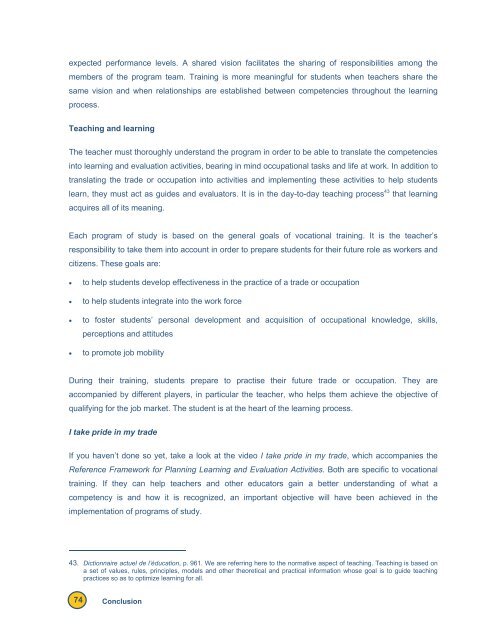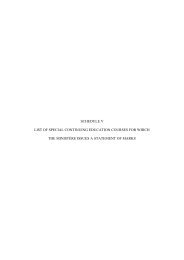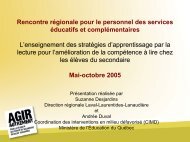Reference Framework for Planning Learning and Evaluation Activities
Reference Framework for Planning Learning and Evaluation Activities
Reference Framework for Planning Learning and Evaluation Activities
You also want an ePaper? Increase the reach of your titles
YUMPU automatically turns print PDFs into web optimized ePapers that Google loves.
expected per<strong>for</strong>mance levels. A shared vision facilitates the sharing of responsibilities among the<br />
members of the program team. Training is more meaningful <strong>for</strong> students when teachers share the<br />
same vision <strong>and</strong> when relationships are established between competencies throughout the learning<br />
process.<br />
Teaching <strong>and</strong> learning<br />
The teacher must thoroughly underst<strong>and</strong> the program in order to be able to translate the competencies<br />
into learning <strong>and</strong> evaluation activities, bearing in mind occupational tasks <strong>and</strong> life at work. In addition to<br />
translating the trade or occupation into activities <strong>and</strong> implementing these activities to help students<br />
learn, they must act as guides <strong>and</strong> evaluators. It is in the day-to-day teaching process 43 that learning<br />
acquires all of its meaning.<br />
Each program of study is based on the general goals of vocational training. It is the teacher’s<br />
responsibility to take them into account in order to prepare students <strong>for</strong> their future role as workers <strong>and</strong><br />
citizens. These goals are:<br />
• to help students develop effectiveness in the practice of a trade or occupation<br />
• to help students integrate into the work <strong>for</strong>ce<br />
• to foster students’ personal development <strong>and</strong> acquisition of occupational knowledge, skills,<br />
perceptions <strong>and</strong> attitudes<br />
• to promote job mobility<br />
During their training, students prepare to practise their future trade or occupation. They are<br />
accompanied by different players, in particular the teacher, who helps them achieve the objective of<br />
qualifying <strong>for</strong> the job market. The student is at the heart of the learning process.<br />
I take pride in my trade<br />
If you haven’t done so yet, take a look at the video I take pride in my trade, which accompanies the<br />
<strong>Reference</strong> <strong>Framework</strong> <strong>for</strong> <strong>Planning</strong> <strong>Learning</strong> <strong>and</strong> <strong>Evaluation</strong> <strong>Activities</strong>. Both are specific to vocational<br />
training. If they can help teachers <strong>and</strong> other educators gain a better underst<strong>and</strong>ing of what a<br />
competency is <strong>and</strong> how it is recognized, an important objective will have been achieved in the<br />
implementation of programs of study.<br />
43. Dictionnaire actuel de l’éducation, p. 961. We are referring here to the normative aspect of teaching. Teaching is based on<br />
a set of values, rules, principles, models <strong>and</strong> other theoretical <strong>and</strong> practical in<strong>for</strong>mation whose goal is to guide teaching<br />
practices so as to optimize learning <strong>for</strong> all.<br />
74 Conclusion




